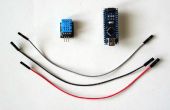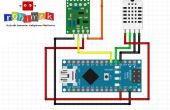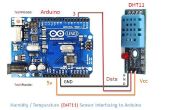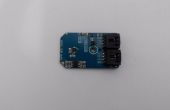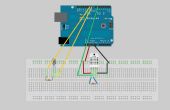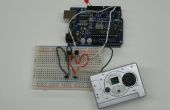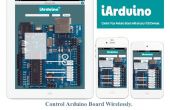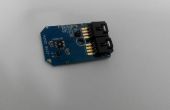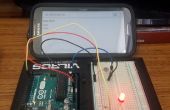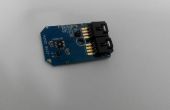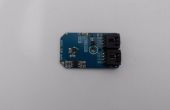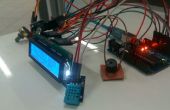Paso 2: Cableado de la sonda de temperatura y humedad
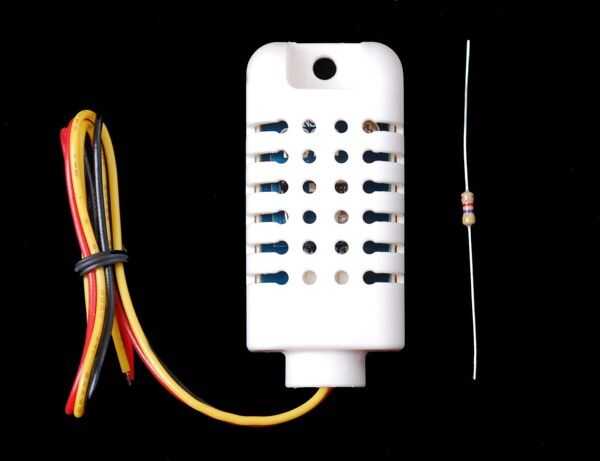
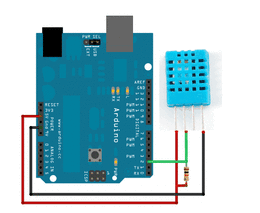
Es muy fácil de configurar dos sensores separados para esto, utilicé un sensor que lee la temperatura y la humedad. Sensores DHT son baratos y capaces de leer la temperatura y la humedad. Tiene cuatro clavijas y conectar como se indica a continuación:
- VCC (3V-5V de la energía)
- Datos hacia fuera
- No hay conexión
- Tierra
Conecte un resistor de 10K entre las líneas de datos y VCC. Un diagrama es mostrado.
Para poder utilizar los sensores DHT necesita descargar la biblioteca de la DHT. Aquí está uno de Adafruit. Para utilizarlo, descargue los archivos DHT.cpp y DHT.h y ponerlos en una carpeta llamada "DHT" en la carpeta "libraries" de arduino.
Aquí es un código de ejemplo de adafruit para su sensor DHT:
// Example testing sketch for various DHT humidity/temperature sensors// Written by ladyada, public domain#include "DHT.h"#define DHTPIN 2 // what pin we're connected to// Uncomment whatever type you're using! //#define DHTTYPE DHT11 // DHT 11 #define DHTTYPE DHT22 // DHT 22 (AM2302) //#define DHTTYPE DHT21 // DHT 21 (AM2301)// Connect pin 1 (on the left) of the sensor to +5V // NOTE: If using a board with 3.3V logic like an Arduino Due connect pin 1 // to 3.3V instead of 5V! // Connect pin 2 of the sensor to whatever your DHTPIN is // Connect pin 4 (on the right) of the sensor to GROUND // Connect a 10K resistor from pin 2 (data) to pin 1 (power) of the sensor// Initialize DHT sensor for normal 16mhz Arduino DHT dht(DHTPIN, DHTTYPE); // NOTE: For working with a faster chip, like an Arduino Due or Teensy, you // might need to increase the threshold for cycle counts considered a 1 or 0. // You can do this by passing a 3rd parameter for this threshold. It's a bit // of fiddling to find the right value, but in general the faster the CPU the // higher the value. The default for a 16mhz AVR is a value of 6. For an // Arduino Due that runs at 84mhz a value of 30 works. // Example to initialize DHT sensor for Arduino Due: //DHT dht(DHTPIN, DHTTYPE, 30);void setup() { Serial.begin(9600); Serial.println("DHTxx test!"); dht.begin(); }void loop() { // Wait a few seconds between measurements. delay(2000); // Reading temperature or humidity takes about 250 milliseconds! // Sensor readings may also be up to 2 seconds 'old' (its a very slow sensor) float h = dht.readHumidity(); // Read temperature as Celsius float t = dht.readTemperature(); // Read temperature as Fahrenheit float f = dht.readTemperature(true); // Check if any reads failed and exit early (to try again). if (isnan(h) || isnan(t) || isnan(f)) { Serial.println("Failed to read from DHT sensor!"); return; } // Compute heat index // Must send in temp in Fahrenheit! float hi = dht.computeHeatIndex(f, h); Serial.print("Humidity: "); Serial.print(h); Serial.print(" %\t"); Serial.print("Temperature: "); Serial.print(t); Serial.print(" *C "); Serial.print(f); Serial.print(" *F\t"); Serial.print("Heat index: "); Serial.print(hi); Serial.println(" *F"); }
